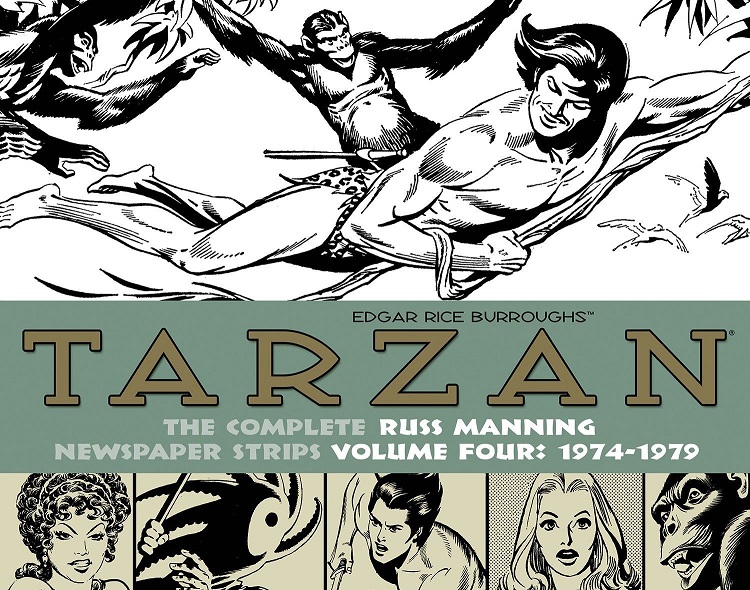
With the Library of America Comics releasing the fourth and final volume in the Eisner Award-winning series, they have published the complete collection of Russ Manning’s Tarzan newspaper strips. As Henry G. Franke III, editor of The Burroughs Bibliophiles, explains in his informative introduction of the strip and its author, Manning was only creating Sunday strips at this point in the run, having given up the dailies in order to add Tarzan graphic novels to his workload.
However, interest in the strip and the character had waned by the end of the decade. In February 1979, Tarzan “was appearing in only thirty domestic newspapers…[and] the Asbury Park Press was the only newspaper in the country that still carried the strip in the complete half-newspaper page.” Earning a living finally forced Manning to give up his dream job of creating adventures about his childhood hero, but thankfully, he maintained the same high quality of writing and art to the end. The nine stories in this collection ran from March 24, 1974 to June 24, 1979, with seven starring Tarzan and two starring his son Korak.
The book opens with “Tarzan Returns to Castra Sanguinarius.” While the character had never been there before in Manning’s strip, he had previously visited in Edgar Rice Burroughs’ novel Tarzan and the Lost Empire where he discovered “a city founded by soldiers of Ancient Rome in a hidden valley.” Manning does a fantastic job showing what Tarzan would have looked like running the streets of Rome, leading a rebellion of slaves and animals.
In “Tarzan and the Valley of Mist,” Manning infuses philosophy into the adventure strip as Tarzan argues against using magical mists to strip away a creature’s “urge to ever hurt anyone,” and the reader sees a potential problem their use can cause. While the King of the Jungle has been known to speak to the animals, this storyline is the first I remember where a creature, Nkima the monkey, speaks to him in English.
Korak and some outsiders meet the Amazons of the Elephants’ Graveyard and they appear to be two different factions based on their outfits. It was a surprise to see the warrior women of legend subservient to the armored villain of the story, especially considering their numbers alone should have allowed them to overwhelm and defeat him. Unfortunately during Manning’s tenure, most, if not all, of the female characters are basically damsels in distress needing rescue.
Manning creates great thrills in “Tarzan and the Giant Insects of Opar” as our hero not only battles against the Beast-Men of Opar, but has to contend with oversized beetles, dragon-flies, a spider, an ant-lion, and women who desire him as a mate. The depictions of the oversized creatures are believable. “Tarzan and the Emigrants” begins with a similar premise to a story I had previously read by artist Burne Hogarts and writer Don Garden from approximately 30 years earlier about entitled European settlers not understanding the ways of Africa.
Monster lovers will enjoy the next two stories. “Tarzan and the Jungle Revolution” begins as a tale of political intrigue with General Fernandez leading a revolt against the government, but the characters eventually find themselves dealing with dinosaurs. Manning places Jane in great danger, and then sends the narrative back in time to show Tarzan racing to save her. In “Korak and the Sacred Lake of Krackao,” Korak meets a tribe that worships a giant squid.
“Tarzan and the Dead Moon of Pellucidar” finds our hero returning to the strange land inside the Earth to help explorer David Innes, a character that first appeared in Burrough’s novel At the Earth’s Core. It’s a marvelous yearlong epic that finds many creatures teaming up to fight against the dreaded Mahars whose villainy has dangerous ramifications on both the surface and interior worlds. It would have made for a triumphant send-off for Manning, but instead his final swan song is much smaller in size and scope about corruption in the games of Ibizzia.
As great of a storyteller Russ Manning was with words, he was even greater with pictures. The images alone are compelling enough to keep a reader turning the page. The colors he used to create scenes taking place within shadows or darkness are well chosen. The highlights of the book are seen in the expanded panels that drew the audience in even further to the moment.
The Library of America Comics has done an outstanding job with this entire series, and Franke reveals “it fulfills the cartoonist’s own longstanding desire to see his work reprint in hardcover, which he equated to respect and even a degree of immortality.” It is unfortunate Manning, who died in December 1981, didn’t live to see it, but I am thankful to have read it all.